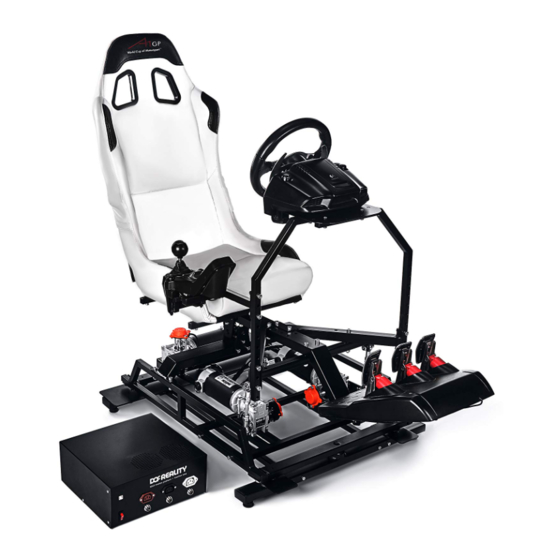
Table of Contents
Advertisement
WARNING! Assembled platform will have exposed motors moving parts. Neven operate it with the
small children around or use optional protection caver.
During initial assembly don't tighten bolts completely, rather do it at the end of the assembly.
Please First assemble the entire frame and tighten screws and bolts afterwards.
The following arrow highlights a location on the diagram or details where you need to pay extra
attention:
Please check the motor's power and sensors to ensure the plug colors match. This is very
important. Never change wiring. Mismatched connector colors can damage the motors and platform
controllers.
Our platform is very lightweight and simple due to its perfect weight balance. This allows us to
use affordable motors and gearboxes. If you plan to put something besides standard wheel, pedals,
yoke, gear shifter, throttle and HOTAS you need to plan and implement it properly. Each additional,
even light element on the moving platform should be well positioned and counterbalanced (same
weight X same arm length). You can't put even a lightweight screen/monitor on our simulator. It is
always better to consult us first, before installing any extra equipment on the platform.
Don't put ANY accessories (joystick, pedals etc) on the platform before it is completely tested
and proven to be working as desired. After assembly, attach the seat only. Nothing extra. When you
ensure proper behavior start adding controllers one by one, doing movement tests with a person
seating in the pilot seat after each new addion to the platform weight.
If your control box don't have colored motors plugs: left motor brown plug is Motor 1, right 2
black plug, rear Motor 3 white plug
1
Assembly Instructions DOF Reality H3 and P3
Advertisement
Table of Contents

Summarization of Contents
1. Lower frame assembly P3
1.1. Assembly Traction Loss Base
Assembles the base structure, ensuring correct orientation of the traction loss bar.
2. Upper frame DOF Reality
2.1. Attach main rail to lower frame with U-joint
Connects the main rail to the lower frame using the U-joint.
2.2. Attach front lateral bracket
Attaches the front lateral bracket, ensuring correct orientation.
2.3. Attach pedals stand and front motors
Mounts the pedals stand and the front motors onto the platform.
2.4. Attach seat mount brackets
Secures the seat mount brackets and optionally the seat and wheel support mounts.
2.5. Attach wheel and shifter stand
Mounts the wheel and shifter stand to the main rail for stability.
2.6. Attach wheel plate and shifter bracket
Installs the wheel plate and the shifter holder bracket.
4. Software installation
4.1. Get SimRacingStudio (SRS) app
Guides users to download and review the SimRacingStudio (SRS) application.
4.2. Activate software license
Details the process of activating the software license via the LICENSE tab.
4.3. Check motion tab connection
Verifies the simulator's connection and model in the MOTION tab.
4.4. Set motion mode to Off
Explains how to set the mode to 'Off' to halt platform motion.
4.5. Test motion with MOTION TEST tab
Tests motion functionality by moving sliders in the MOTION TEST tab.
4.6. Use AUTO INSTALL for game setup
Installs plugins and game settings via AUTO INSTALL for game compatibility.
4.7. SRS automatic game connection
Explains SRS game connection process, noting potential game-specific requirements.
4.8. Tune SRS app for experience
Describes SRS app tuning for optimal motion, with live adjustment capabilities.
4.9. Find help in FAQ section
Directs users to the FAQ section for further assistance and information.
4.10. Mandatory platform balancing
Mandatory step to balance the platform for optimal performance and longevity.
4.11. SRS tuning tips resources
Provides links to resources for advanced SRS tuning and troubleshooting motion issues.
5. Troubleshooting & Maintenance
5.1 Platform connection issues in SRS
Diagnoses and fixes connection problems between the platform and SRS software.
5.2 Simulator not moving in games
Resolves issues where the simulator works in tests but not in games via Auto Install.
5.3 Stuck or unresponsive motors
Procedure to unlock motors that are stuck in a protection zone or unresponsive.
5.4 Motor arm neutral position calibration
Calibrates the motor arm to ensure it returns to a correct horizontal neutral position.
5.5 General platform malfunction troubleshooting
General steps for platform malfunctions, checking connections and using SMC3Utils.
5.6 Antivirus issues with SRS installation
Addresses antivirus flagging SRS, suggesting creating an exception.
5.7 Simulator not moving in-game
Ensures simulator functions correctly in games, checking settings and Auto Install.
5.8 Simulator stopped working
Resolves issues where simulator connection or functionality stops during gameplay.
5.9 Motors make small adjustments
Explains minor motor movements when the platform is powered but not under load.
5.10 Strange simulator behavior in games
Common causes for erratic simulator behavior in games, including balance and settings.
6 Reparation
Unauthorized repair warning
Warns against unauthorized repair personnel and the potential consequences of non-compliance.





Need help?
Do you have a question about the P3 and is the answer not in the manual?
Questions and answers